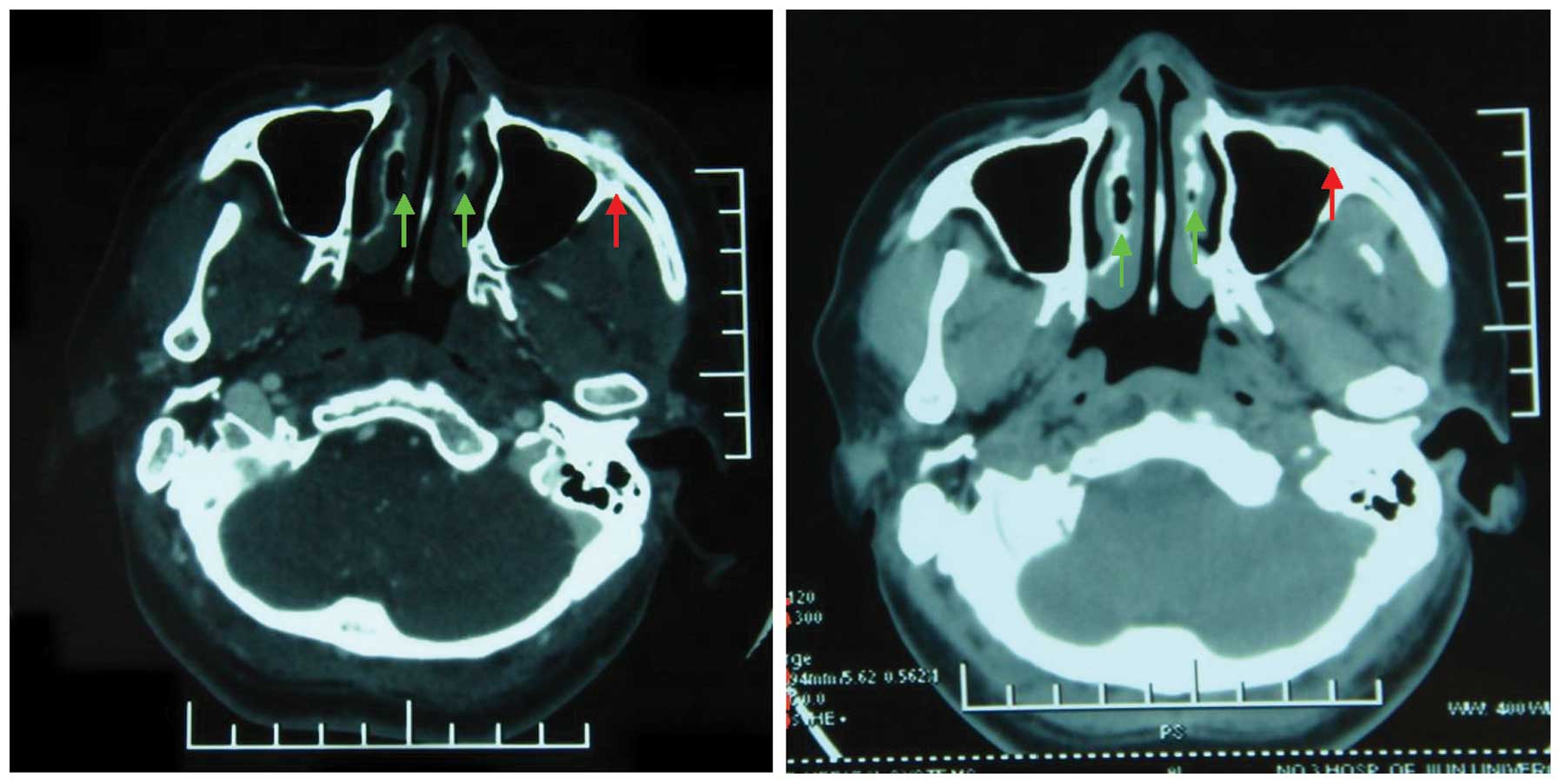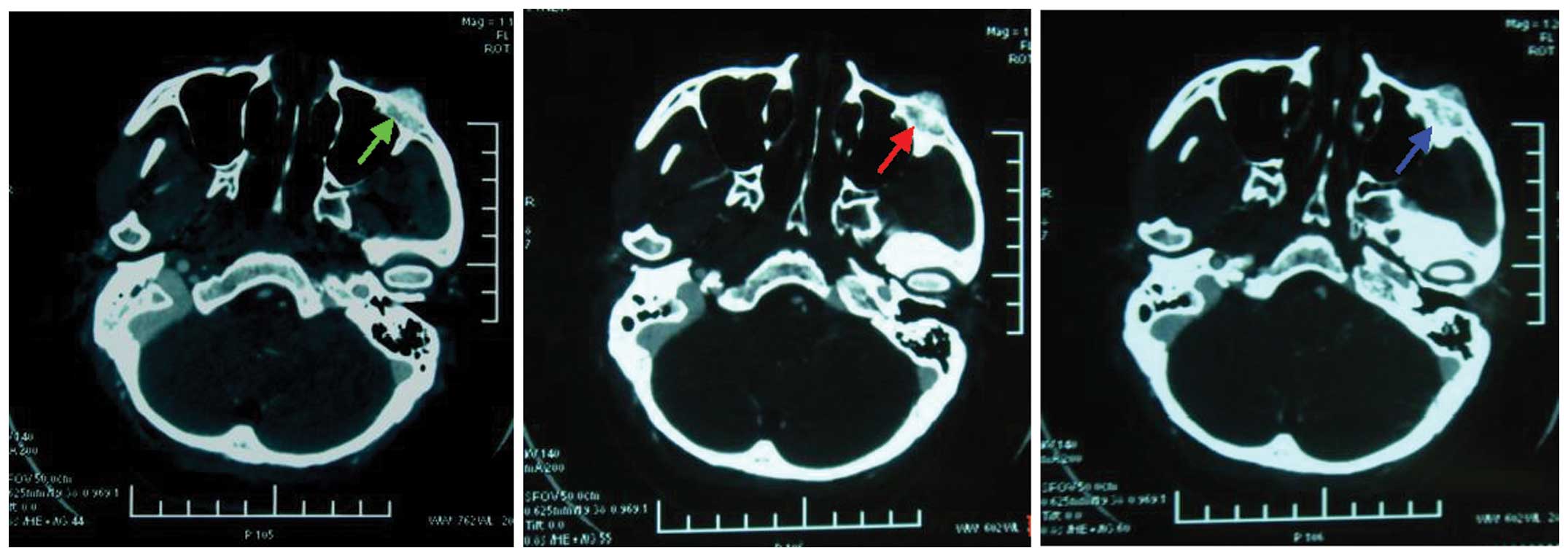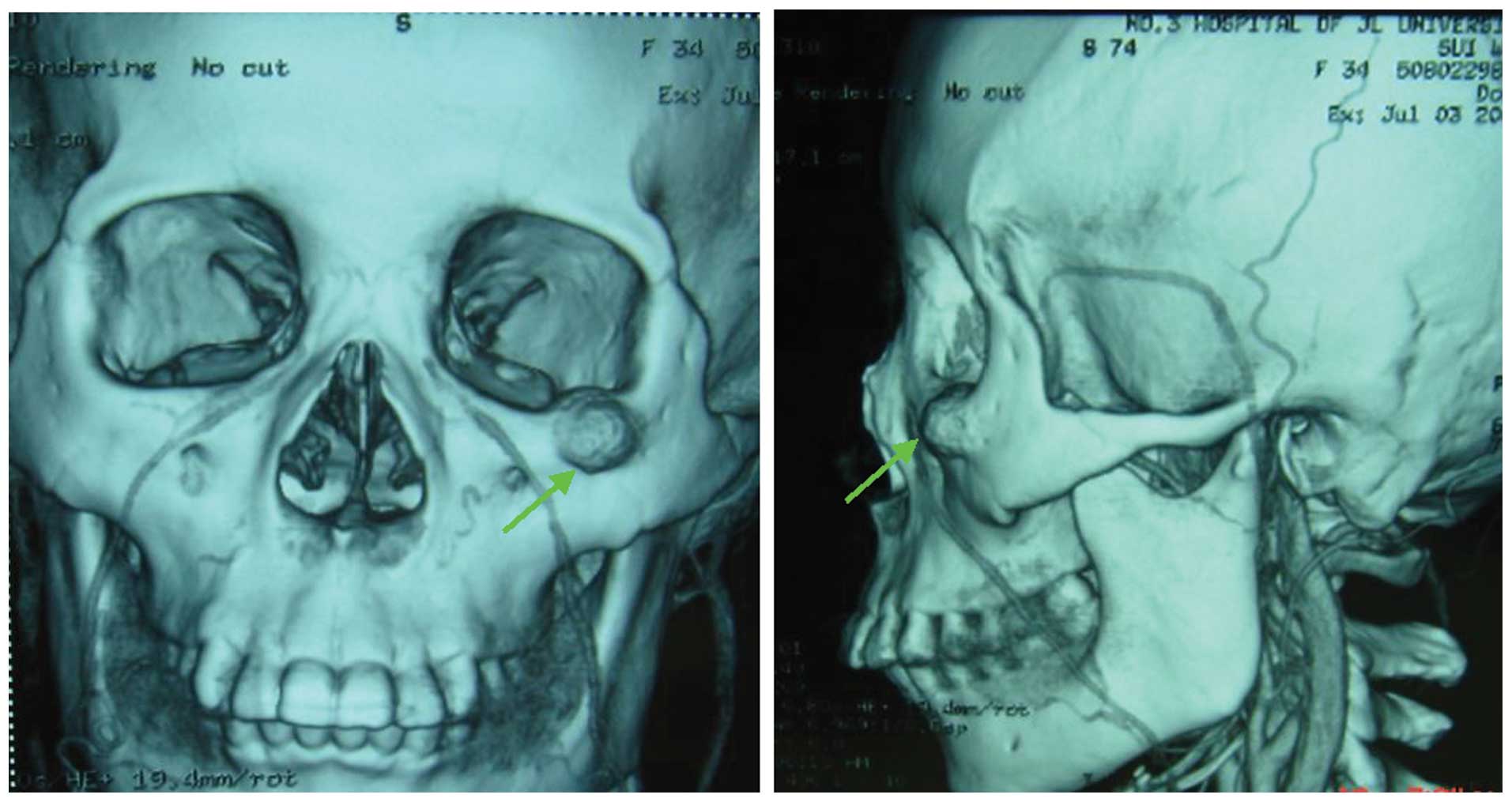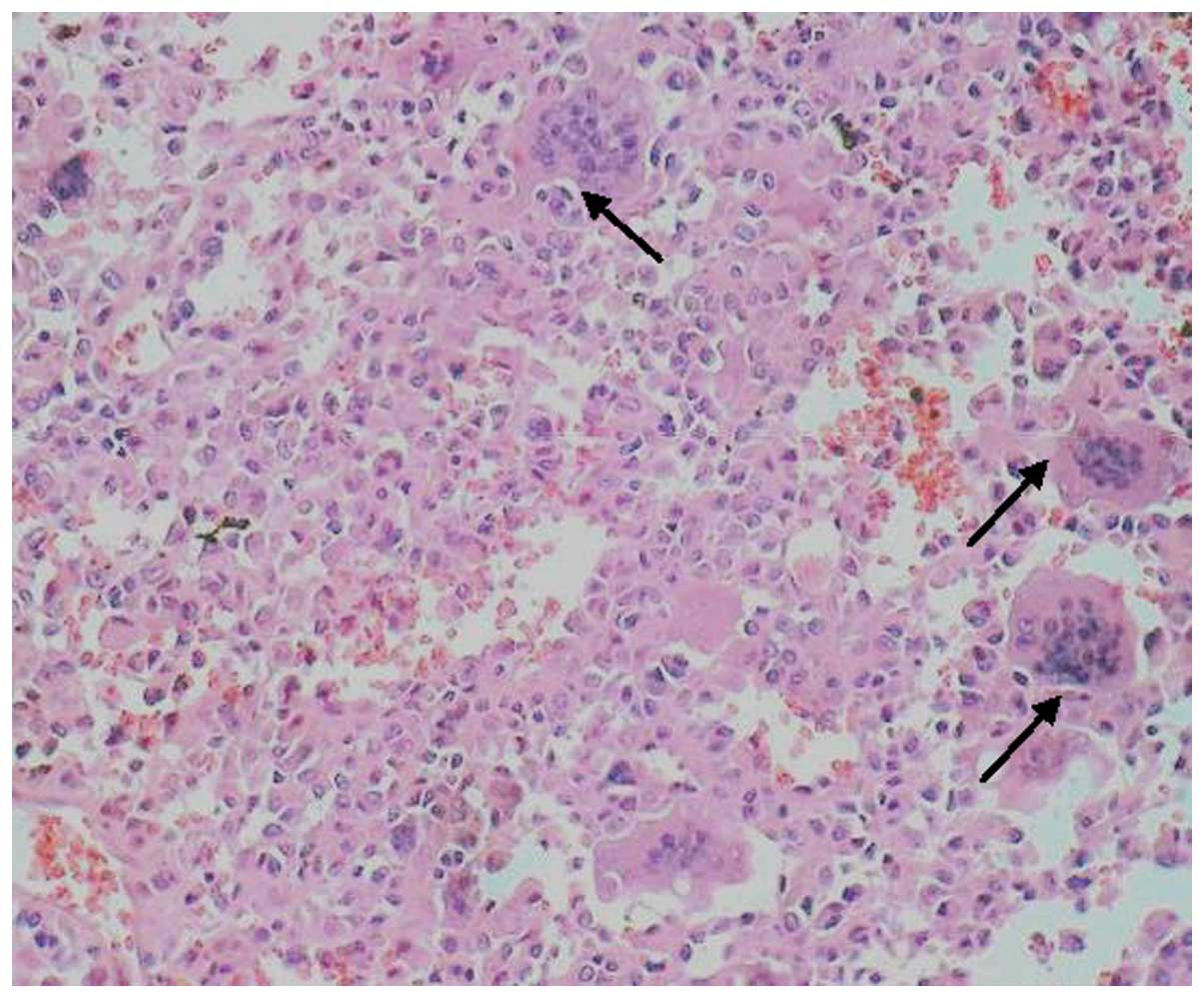Aneurysmal bone cyst on the left zygomatic arch concomitant with bilateral inferior turbinate gasification in an adult female: A case report
- Authors:
- Published online on: December 9, 2015 https://doi.org/10.3892/ol.2015.4016
- Pages: 1146-1148
Abstract
Introduction
Aneurysmal bone cyst (ABC) is an uncommon benign bone tumor, more commonly affecting children than adults (1). It is mostly observed in the spine and long bones (2). ABC was first reported by Jaffe and Lichtenstein in 1942 (3), although the pathogenic mechanism that produces these benign lesions is still not completely understood. The symptoms include local swelling, pain and related functional disorders. X-ray computed tomography (CT) scan, contrast-enhanced CT and three-dimensional reconstruction may be used in the diagnosis of ABC. The inferior turbinate (inferior nasal concha) is considered an independent osteocomma with its own ossification center. Pneumatized inferior turbinate was first described by Zinreich et al in 1988 (4), and is rarely observed in the clinic (5). Sinus CT examination is the gold standard for the diagnosis of inferior turbinate gasification, with snuffles, headache and weeping among the common clinical symptoms. Herein we report the case of an ABC on the left zygomatic arch concomitant with bilateral inferior turbinate gasification in an adult female.
The study was performed in accordance with the Declaration of Helsinki on medical protocol and ethics, and was approved by the regional Ethical Review Board of China-Japan Union Hospital (Changchun, China). Written informed consent was obtained from the patient for the publication of this study and accompanying images.
Case report
A 34-year-old Chinese Han female, suffering from hyperplasia of the left maxillary bone for one and a half years, was admitted to the China-Japan Union Hospital in June 2008. The patient was otherwise healthy and had no history of giant cell tumor, osteochondritis, hemangioma, chondroblastoma or trauma. Routine examinations revealed that a bony prominence with a diameter of 1.5 cm was present in the middle area of the patient's left zygomatic arch. The bony prominence felt rigid and was painless. There was no notable difference between the skin covering the bony prominence and the surrounding skin.
CT scans of the paranasal sinus revealed bilateral inferior turbinate gasification and a round, alveolate high-density cyst on the left zygomatic arch (Fig. 1). The cyst had a clear boundary and was close to the lateral wall of the left maxillary sinus. The contrast-enhanced CT scans revealed no distinctive enhancement characteristics in either the arterial or venous phases (Fig. 2). In addition, three-dimensional maxillofacial reconstruction revealed a round cyst located in the area where the left zygomatic arch intersected the maxillary bone (Fig. 3). The surface of the cyst was fairly smooth, and the superior wall of the left maxillary sinus was intact.
The patient underwent resection of the cyst on the left maxillary bone. On examination, the cyst appeared alveolate, and no clear boundary could be identified with the surrounding normal bones. Arterial blood was drawn by puncture, and compression was applied to stop the bleeding. Curettage of the cyst was performed. The left maxillary sinus was not affected by the cyst.
The blood lacuna and connective tissue compartment are shown in Fig. 4. Tissue cells and osteoclast-like multinuclear giant cells were observed under an optical microscope. There was no evidence of new reactive bone formation.
The patient was followed up for 4 years. The ABC did not reoccur and no other postoperative symptoms were observed.
Discussion
The majority of ABC cases occur in the spine or long bones of female patients less than 20 years old (6,7). In general, the pathophysiology of ABC is consequential rather than causal, induced by hemodynamic abnormalities in local blood vessels due to giant cell tumor, osteochondritis, hemangioma, chondroblastoma or trauma. An ABC on the zygomatic arch is rather rare.
In the present study, an alveolate high-density cyst was present on the left zygomatic arch of the patient. Her left maxillary sinus was not affected by the cyst. The ABC in this case was considered primary, as no notable antecedent disease was observed, although the pathogenic mechanism was unclear.
The standard treatment for ABCs consists mainly of surgical resection, which may involve a simple cyst resection or radical resection. The necessity of a bone graft depends on the size of the bone defect (8). The resection area is custom-determined by the characteristics of the pre-existing lesion. If the lesion is caused by trauma or the etiology is unclear, a pure cyst resection should be performed. Alternatively, arterial embolization may be applied in those cases where surgical resection is not feasible, and the clinical outcome is considered equal to that of surgery (9). There is no consensus with regard to whether radiotherapy should be applied before surgery, to reduce intraoperative hemorrhage, or after surgery, to reduce the risk of recurrence. However, compression with control is recommended if required to alleviate bleeding, as intraoperative hemorrhage is common. In particular, severe bleeding usually occurs when the cyst is large. In these cases artery ligation combined with interventional vascular embolization may be applied to reduce bleeding prior to surgery. The recurrence rate of ABC has been reported to be 20%, and 90% of these cases occurred within two years of surgery (6). The recurrence rate is generally correlated with the etiology, and ABCs induced by giant cell tumor or trauma recurred relatively frequently.
The inferior turbinate is an independent bone that originates from the lateral nasal wall. It is covered with a thick mucous membrane that contains a plexus cavernosus (10). Pneumatized inferior turbinate has been rarely reported in the clinical setting (11), and reports of bilateral inferior turbinate gasification are rarer still (12,13). The potential pathogenic mechanisms for inferior turbinate gasification include: i) pneumatization induced by involvement of epithelial cells in the cartilage framework of the inferior turbinate; ii) disease in the maxillary sinus; iii) articulation defects between the maxillary process of the palatine bone and the maxillary bone.
In the present case, there were no evident clinical symptoms for bilateral inferior turbinate gasification; it was identified incidentally through CT examination of the ABC. Therefore, none of the three pathogenic mechanisms described above apply in this case. Oztürk et al (14) indicated that the formation of inferior turbinate gasification may also be gene-related. Winnepenninckx et al (15) reported that a specific gene (mapped to 17p13) was involved in the development of an ABC. Therefore, we consider that a gene abnormality might be responsible in the present case, as the ABC and inferior turbinate gasification were maxillofacial and characterized by a bubble change in the bone substance. However, gene mutation screening was refused by the patient so this cannot be confirmed.
This study constitutes the first case report of an ABC on the left zygomatic arch concomitant with bilateral inferior turbinate gasification, observed in a Chinese Han female who was successfully treated with surgical resection of the cyst. The case was considered to be associated with an abnormality of specific genes.
References
|
Zenonos G, Jamil O, Governale LS, Jernigan S, Hedequist D and Proctor MR: Surgical treatment for primary spinal aneurysmal bone cysts, experience from Children's Hospital Boston. J Neurosurg Pediatr. 9:305–315. 2012. View Article : Google Scholar : PubMed/NCBI | |
|
Dekeuwer P, Odent T, Cadilhac C, Journeau P, Langlais J, Padovani JP, Glorion C and Pouliquen JC: Aneurysmal bone cyst of the spine in children, a 9-year follow-up of 7 cases and review of the literature. Rev Chir Orthop Reparatrice Appar Mot. 89:97–106. 2003.(In French). PubMed/NCBI | |
|
Jaffe HL and Lichtenstein L: Solitary unicameral bone cyst: with emphasis on the roentgen picture the pathologic appearance and the pathogenesis. Arch Surg. 44:1004–1025. 1942. View Article : Google Scholar | |
|
Zinreich SJ, Mattox DE, Kennedy DW, Chisholm HL, Diffley DM and Rosenbaum AE: Concha bullosa, CT evaluation. J Comput Assist Tomogr. 12:778–784. 1988. View Article : Google Scholar : PubMed/NCBI | |
|
Pittore B: AlS afi W and Jarvis SJ: Concha bullosa of the inferior turbinate: an unusual cause of nasal obstruction. Acta Otorhinolaryngol Ital. 31:47–49. 2011.PubMed/NCBI | |
|
Triantafillidou K, Venetis G, Karakinaris G, Iordanidis F and Lazaridou M: Variable histopathological features of 6 cases of aneurysmal bone cysts developed in the jaws, review of the literature. J Craniomaxillofac Surg. 40:e33–e38. 2012. View Article : Google Scholar : PubMed/NCBI | |
|
Rajput D, Tungaria A, Jaiswal A and Jain V: Aneurysmal bone cyst of clivus and C1 C2: case report and review of literature. Turk Neurosurg. 22:105–108. 2012.PubMed/NCBI | |
|
Karabouta I, Tsodoulos S and Trigonidis G: Extensive aneurysmal bone cyst of the mandible, surgical resection and immediate reconstruction. Histopathology. Oral Surg Oral Med Oral Pathol. 71:148–150. 1991. View Article : Google Scholar : PubMed/NCBI | |
|
Donati D, Frisoni T, Dozza B, DeGroot H, Albisinni U and Giannini S: Advance in the treatment of aneurysmal bone cyst of the sacrum. Skeletal Radiol. 40:1461–1466. 2011. View Article : Google Scholar : PubMed/NCBI | |
|
Christmas DA Jr, Merrell RA Jr, Mirante JP and Yanagisawa E: Pneumatized inferior turbinate: report of three cases. Ear Nose Throat J. 83:152–153. 2004.PubMed/NCBI | |
|
Uzun L, Ugur MB and Savranlar A: Pneumatization of the inferior turbinate. Eur J Radiol. 51:99–101. 2004. | |
|
Gocmen H, Oğuz H, Ceylan K and Samim E: Infected inferior turbinate pneumatization. Eur Arch Otorhinolaryngol. 262:979–981. 2005. View Article : Google Scholar : PubMed/NCBI | |
|
Kharoubi S: Pneumatization (concha bullosa) of the inferior turbinate: case report and literature review. Rev Laryngol Otol Rhinol (Bord). 131:321–324. 2010.(In French). PubMed/NCBI | |
|
Oztürk A, Alataş N, Oztürk E, San I, Sirmatel O and Kat N: Pneumatization of the inferior turbinates, incidence and radiologic appearance. J Comput Assist Tomogr. 29:311–314. 2005. View Article : Google Scholar : PubMed/NCBI | |
|
Winnepenninckx V, Debiec-Rychter M, Jorissen M, Bogaerts S and Sciot R: Aneurysmal bone cyst of the nose with 17p13 involvement. Virchows Arch. 439:636–639. 2001. View Article : Google Scholar : PubMed/NCBI |













